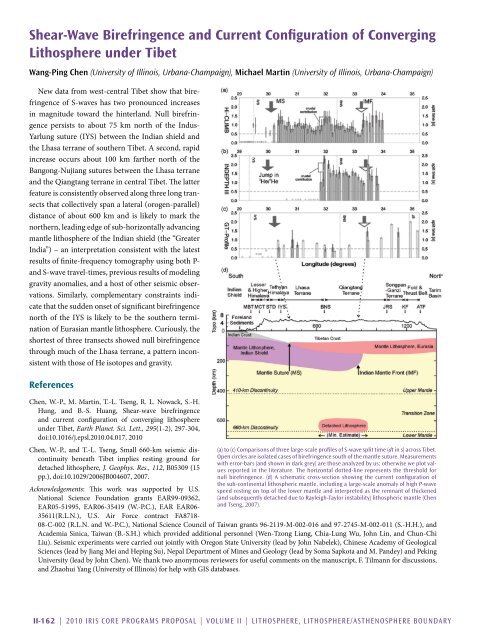Download Volume II Accomplisments (28 Mb pdf). - IRIS
Download Volume II Accomplisments (28 Mb pdf). - IRIS
Download Volume II Accomplisments (28 Mb pdf). - IRIS
Create successful ePaper yourself
Turn your PDF publications into a flip-book with our unique Google optimized e-Paper software.
Shear-Wave Birefringence and Current Configuration of Converging<br />
Lithosphere under Tibet<br />
Wang-Ping Chen (University of Illinois, Urbana-Champaign), Michael Martin (University of Illinois, Urbana-Champaign)<br />
New data from west-central Tibet show that birefringence<br />
of S-waves has two pronounced increases<br />
in magnitude toward the hinterland. Null birefringence<br />
persists to about 75 km north of the Indus-<br />
Yarlung suture (IYS) between the Indian shield and<br />
the Lhasa terrane of southern Tibet. A second, rapid<br />
increase occurs about 100 km farther north of the<br />
Bangong-Nujiang sutures between the Lhasa terrane<br />
and the Qiangtang terrane in central Tibet. The latter<br />
feature is consistently observed along three long transects<br />
that collectively span a lateral (orogen-parallel)<br />
distance of about 600 km and is likely to mark the<br />
northern, leading edge of sub-horizontally advancing<br />
mantle lithosphere of the Indian shield (the “Greater<br />
India”) – an interpretation consistent with the latest<br />
results of finite-frequency tomography using both P-<br />
and S-wave travel-times, previous results of modeling<br />
gravity anomalies, and a host of other seismic observations.<br />
Similarly, complementary constraints indicate<br />
that the sudden onset of significant birefringence<br />
north of the IYS is likely to be the southern termination<br />
of Eurasian mantle lithosphere. Curiously, the<br />
shortest of three transects showed null birefringence<br />
through much of the Lhasa terrane, a pattern inconsistent<br />
with those of He isotopes and gravity.<br />
References<br />
Chen, W.-P., M. Martin, T.-L. Tseng, R. L. Nowack, S.-H.<br />
Hung, and B.-S. Huang, Shear-wave birefringence<br />
and current configuration of converging lithosphere<br />
under Tibet, Earth Planet. Sci. Lett., 295(1-2), 297-304,<br />
doi:10.1016/j.epsl.2010.04.017, 2010<br />
Chen, W.-P., and T.-L. Tseng, Small 660-km seismic discontinuity<br />
beneath Tibet implies resting ground for<br />
detached lithosphere, J. Geophys. Res., 112, B05309 (15<br />
pp.), doi:10.1029/2006JB004607, 2007.<br />
Acknowledgements: This work was supported by U.S.<br />
National Science Foundation grants EAR99-09362,<br />
EAR05-51995, EAR06-35419 (W.-P.C.), EAR EAR06-<br />
35611(R.L.N.), U.S. Air Force contract FA8718-<br />
(a) to (c) Comparisons of three large-scale profiles of S-wave split time (dt in s) across Tibet.<br />
Open circles are isolated cases of birefringence south of the mantle suture. Measurements<br />
with error-bars (and shown in dark grey) are those analyzed by us; otherwise we plot values<br />
reported in the literature. The horizontal dotted-line represents the threshold for<br />
null birefringence. (d) A schematic cross-section showing the current configuration of<br />
the sub-continental lithospheric mantle, including a large-scale anomaly of high P-wave<br />
speed resting on top of the lower mantle and interpreted as the remnant of thickened<br />
(and subsequently detached due to Rayleigh-Taylor instability) lithospheric mantle (Chen<br />
and Tseng, 2007).<br />
08-C-002 (R.L.N. and W.-P.C.), National Science Council of Taiwan grants 96-2119-M-002-016 and 97-2745-M-002-011 (S.-H.H.), and<br />
Academia Sinica, Taiwan (B.-S.H.) which provided additional personnel (Wen-Tzong Liang, Chia-Lung Wu, John Lin, and Chun-Chi<br />
Liu). Seismic experiments were carried out jointly with Oregon State University (lead by John Nabelek), Chinese Academy of Geological<br />
Sciences (lead by Jiang Mei and Heping Su), Nepal Department of Mines and Geology (lead by Soma Sapkota and M. Pandey) and Peking<br />
University (lead by John Chen). We thank two anonymous reviewers for useful comments on the manuscript, F. Tilmann for discussions,<br />
and Zhaohui Yang (University of Illinois) for help with GIS databases.<br />
<strong>II</strong>-162 | 2010 <strong>IRIS</strong> Core Programs Proposal | <strong>Volume</strong> <strong>II</strong> | Lithosphere, Lithosphere/Asthenosphere Boundary
















